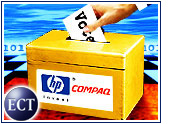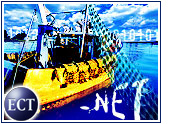
Recent history has shown that there are no sure thingsin e-tailing. And with eyes looking to the future,analysts are hesitant to hail even today’s strongestcompanies as sure long-term victors.
Indeed, in some of the most heated e-commercerivalries, clear winners still have not emerged.
“I have not seen anything that indicates that one hasa leg up on the other,” Giga Information Groupanalyst Andrew Bartels told the E-Commerce Times,acknowledging the step-for-step battle raging betweenTravelocity.com and Expedia.com.
As in online travel, adversaries in the book andgrocery arenas are engaged in hand-to-hand combat.But even Amazon.com has not secured certaintriumph over BarnesandNoble.com; andit is too early in the grocery clash for either Albertson’sor Safeway to pull away from the other, said analysts.
Travelocity vs. Expedia
In the momentum game, Expedia may have a slightedge over rival Travelocity. In thefourth quarter of 2001,Expedia reported net income of US$5 million, slightlyahead of Travelocity’s $4.9 million, and $704 millionin total bookings versus Travelocity’s $630.2 million.
“Expedia is in better shape and more profitable, butdo not count Travelocity out,” Morningstar.com analystDavid Kathman told the E-Commerce Times, maintainingthat Expedia’s advantage is a short-term one.
“They are still neck and neck in terms of market share,” he said.
Parental Control
The pedigrees of their parent companies may be themost significant differentiator between the two firms,analysts agreed.
Sabre Holdings, soon to be sole owner of Travelocity,wields deep travel industryconnections and expertise that might work toTravelocity’s advantage, said Kathman.
“Travelocity may offer deeper integration,” addedBartels.
But when the travel industry falters — as it did inthe fall of 2001 — Travelocity will feel the effectsof a slowdown more directly, Kathman cautioned.
For its part, principal Expedia owner and media giantUSA Networks lacks Sabre’s industryconnections but could bolster Expedia with itstelevision marketing outlets, according to Kathman.
In addition, with its media know-how, Expedia mayoutpace its rival in terms of usability and design,noted Bartels.
Three’s Company
In the end, there probably will be room in the onlinetravel market not only for Expedia and Travelocity,but also for Pricelinesaid Kathman.
Bartels suggested that Expedia and Travelocity shouldbe more concerned with other airline sites than witheach other.
“Additional discounts that travelers can only get atthese sites pose a competitive issue,” he said. “Astravel agents, both companies are vulnerable to beingdisintermediated.”
Amazon vs. BarnesandNoble.com
On the surface, it may appear that the onlinebookselling race is anything but the nail-biter that isensuing in the travel space.
“Amazon has a bigger customer base thanBarnesandNoble.com and sells more than just books,” saidKathman. “It has become more fiscally prudent over thepast couple years, doing better than BarnesandNoble.comin keeping costs down.”
But some analysts insist that the two firms competemuch more evenly when only the book category isconsidered.
“In an apples-to-apples comparison, it is not clearthat Amazon is winning,” said Bartels. “It is hardto determine the forward momentum in Amazon’sbook business. Amazon could be losing marketshare to BarnesandNoble.com.”
All for One
Barnes & Noble could dramaticallyimprove the performance of its online arm byreabsorbing it into the parent corporation, analystssuggested.
“Barnes & Noble should never have separated” fromits online arm, said Bartels. “BarnesandNoble.comcould leverage multiple sales channels much moreeffectively and boost its market share.”
Some reports indicate that a buyout may already bein the works. If this occurs, Kathman said,BarnesandNoble.com could escape the harsh spotlight ofthe public market and turn around its fortunes.
“There is room for both of these online booksellers,as long as BarnesandNoble.com can stop bleedingcash,” added Kathman.
Albertson’s vs. Safeway
Unlike books, groceries have already failed once as anonline commodity. Remember Webvan? As aresult, a sense of urgency underpins thestandoffbetween Albertson’s and Safeway.
Their relative success may depend directly on howquickly consumers adopt the online grocery shoppingmodel, said analysts.
With a central warehouse fulfillment model,Albertson’s is betting on quick uptake among consumersin the northwestern United States.
In the past, customer volume was not high enough tomake the warehouse fixed-cost model viable, saidBartels. But if adoption takes off, thescale-dependent warehouse system will have superioreconomics and will become profitable as customer volumeswells.
Adoption Acceleration?
On the other hand, Safeway’s UK-based partner Tescohas ridden its in-store order-picking model all theway to profitability in the United Kingdom.
“The question is whether they can import that successinto the U.S.,” said Kathman.
A long-standing consensus had been that fulfillmentcosts through an in-store “pick, pack and ship” systemwould be too high, said Bartels. But Tesco managed toearn sufficient margins on customer fees to coverthese variable fulfillment costs while avoidingfixed capital expenses for warehouses.
In the long term, the Albertson’s warehouse model mayscale better and solidify profitability, but ifcustomer ramp-up lags between now and then, thecompany could struggle, said Bartels.
The dense population of affluent consumers in Oregonand Northern California — initial proving grounds forAlbertson’s and Safeway — bodes well for Albertson’sbet on rapid consumer adoption, suggested Bartels.
And the Winners Are…
In each of these rivalries, the future is far fromordained. Consistent cost control, customeracquisition and multichannel sales executionwill determine the winners.
The good news is that in many industries, there willbe room enough at the top for two.


























































Social Media
See all Social Media